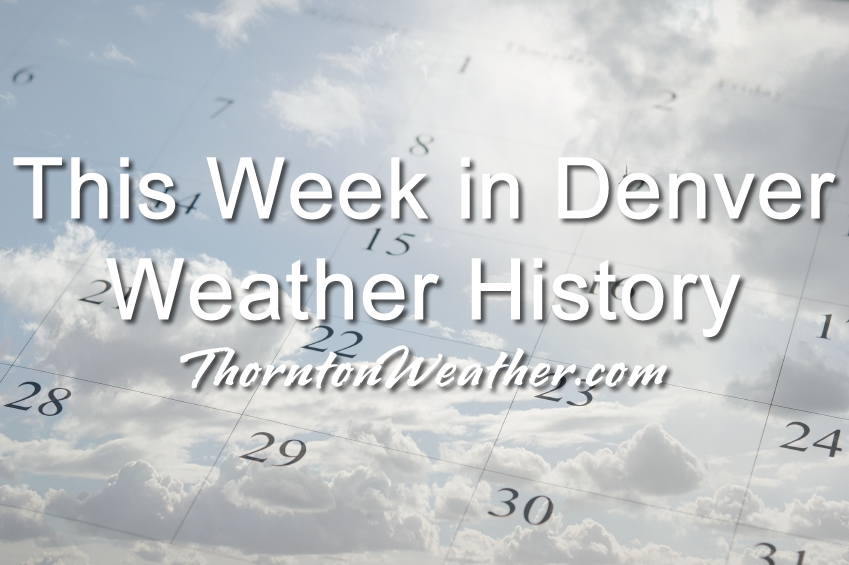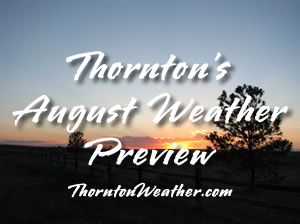
How does 42 degrees sound right about now? That mark is one of the highlights of this week in Denver weather history. It was the low temperature recorded twice in our past and the coldest July temperature on record. Many more notable events have also occurred.
From the National Weather Service:
13-5
In 2008…a streak of 24 consecutive days of 90 degrees shattered the previous record of 18 consecutive days established in 1901 and 1874. Ironically…no new single day record high temperatures were set in the month of July. In August however…a record of 104 degrees was set on the 1st…and another record of 103 degrees was set on the 2nd. In addition…a record low min of 70 degrees was set on August 2nd.
18-2
In 1987…a streak of 16 consecutive days of 90 degrees ranked 4th on the list of hot streaks. The record of 24 consecutive days was established in the summer of 2008.
27-31
In 1956…96 percent of the total precipitation for the month of July occurred over the last five days of the month. Heavy thunderstorms produced 4.00 inches of rainfall at Stapleton Airport. This amount of precipitation in 5 days or less had been exceeded only 3 times in previous record. The last time had been in December of 1913 as snow. Considerable property damage occurred across metro Denver from flooding.
28-30
In 1889…dense smoke from forest fires in the mountains obscured the sun over the city for three days.
In 1971…a vigorous cold front late on the 28th produced northeast wind gusts to 39 mph and record breaking cold temperatures on the 29th and 30th. The temperature dipped to 47 degrees on the 29th and 43 degrees on the 30th… Setting record minimums for the dates. Upslope cloudiness along with rain and fog early on the 29th helped set a record low maximum temperature of 58 degrees for the date.
29-30
In 1997…heavy rain caused flooding and flash flooding in central portions of Adams and Arapahoe counties. Two homes were extensively damaged when water flooded the basements and adjacent pasture area in Strasburg. Water 4 to 5 feet deep had pooled in the lower lying areas of the town. A portion of Quincy Road was closed in Arapahoe County when 4 feet of water covered the roadway. Rainfall totaled 3.06 inches at Denver International Airport…establishing a new record for 24-hour rainfall in July. The previous record was 2.42 inches set in 1965 on the 24th and 25th.
30
In 1879…lightning struck a brick kiln in north Denver. Three men were knocked senseless…but all recovered. Rainfall in the city was only 0.09 inch.
In 1881…a thunderstorm dumped heavy rain and hail on the city…causing street flooding and much damage. A heavy torrent of rain fell with 1.10 inches measured in just 20 minutes. Storm total rainfall was 1.60 inches. The rain turned streets into running streams. Wood street crossings were torn up and washed away. The storm caused great damage by flooding many cellars where goods were stored. The brick yards suffered severe damage when the heavy rainfall destroyed many unfired bricks.
In 1913…northeast winds were sustained to 41 mph with gusts to 48 mph.
In 1939…a thunderstorm produced 0.08 inch of rainfall. This was the only measurable precipitation of the month…making the month the second driest July on record.
In 1961…heavy rain and lightning disrupted power lines and caused flooding in Denver. Thunderstorm rains totaled 1.60 inches at 11th and Lincoln in central Denver.
In 1972…the temperature climbed to a high of 100 degrees at Stapleton International Airport.
In 1983…hail 3/4 to 1 inch in diameter fell in central and southeast Denver and in Littleton. Rainfall of 1.50 inches occurred in just 30 minutes in Littleton. There was some street flooding in both cities with wind gusts up to 55 mph.
In 1984…central Aurora was hit by a downpour that produced 1.80 inches of rain and sent water 2 to 3 feet deep into some streets. Before the rain stopped later in the evening… The storm had dropped as much as 2.80 inches of moisture on the city. Thunderstorm rainfall totaled only 0.82 inch at Stapleton International Airport.
In 1985…a tornado was spotted in open country 10 miles southwest of Bennett. No damage was reported. One inch hail was reported in south Lakewood.
In 1997…one man was killed and his girlfriend critically injured when they were struck by lightning on the Kennedy Golf Course in southeast Denver. Both were struck in the head when they took refuge under a tree during a downpour. Lightning struck a home in unincorporated Arapahoe County east of Buckley Field. The fire started in the electrical panel boxes…causing extensive damage to the home. Heavy rain and hail triggered a flash flood in Boulder…which sent water through a window of the financial aid office on the University of Colorado campus. In addition…ceiling tiles…carpets…and dressing rooms were damaged at the Coors Events Center when a pipe draining rainwater broke during the downpour. In all…10 buildings on the campus received water damage estimated at 100 thousand dollars. Hail as large as 1.25 inches in diameter accompanied the heavy rain in Boulder. Thunderstorm rainfall totaled 2.71 inches at Denver International Airport where west winds gusted to 41 mph. This was the greatest calendar day official precipitation ever recorded in July.
In 1998…heavy rain…up to 3 inches in an hour…caused flash flooding problems from Castle Rock to Parker. I-25 north of Castle Rock was closed as high waters covered sections of the highway. Some cars were left floating in the flood waters.
In 2001…a severe thunderstorm produced a wind gust to 70 mph at a wind sensor on the northeast corner of Denver International Airport.
In 2004…a severe thunderstorm produced wind gusts to 71 mph in Evergreen.
In 2005…the temperature climbed to a high of 101 degrees at Denver International Airport. This was a new record maximum temperature for the date.
In addition…this was the 7th day of the month with a high temperature of 100 degrees or more…which set a new Denver record for the most 100 degree days in a month…for a season…and in a year.
31
In 1873…the all-time lowest recorded temperature in July… 42 degrees…occurred. The same temperature also occurred on July 4…1903.
In 1874…during the late afternoon rain and hail fell for 5 minutes followed by brief heavy rain. Pieces of solid ice of irregular shape fell upon the roof of the station. The hail stones measured 1 1/2 inches in diameter. Precipitation (rain and melted hail) was only 0.16 inch.
In 1889…the high temperature climbed to 100 degrees in downtown Denver.
In 1919…heavy thunderstorm rainfall totaled 2.59 inches in downtown Denver during the evening. Rainfall was 1.90 inches in an hour…a new record at that time.
In 1961…over an inch of rain in a short period of time caused flooding of streets and basements in Denver. Rainfall totaled 1.30 inches at 11th and Lincoln in central Denver.
In 1964…the temperature reached 91 degrees in Denver…making this the 27th day of the month that the temperature reached 90 degrees or more. This is the all time record for 90 degree days in a month in Denver.
In 1972…one inch diameter hail fell in Hudson northeast of Denver.
In 1976…during the evening hours extremely heavy thunderstorm rains produced flash flooding in Big Thompson Canyon which killed 144 people between Estes Park and Loveland. No significant weather occurred in metro Denver at the time.
In 1987…1 inch diameter hail fell in Lakewood and 3/4 inch hail fell near Louisville. Southeast Boulder County was drenched with 1.25 inches of rain in just 20 minutes.
In 1993…thunderstorm winds damaged a chimney of a home near Parker.
In 1996…a weak tornado (f0) was sighted 12 miles east of Denver International Airport. No damage was reported.
In 1998…heavy monsoonal thunderstorm rain triggered a mud slide in Blackhawk. The mudslide blocked Main St. and caused an estimated half million dollars in damage to a casino. Heavy thunderstorm rain…up to 3 inches in an hour…caused a flash flood along Buffalo Creek. Portions of County Road 126 just south of the town of Buffalo Creek were washed out. The flood waters nearly washed away the bridge as mud and debris slammed into the structure. Hail to 1 3/4 inches in diameter fell near Idaho Springs.
In 2004…severe thunderstorm winds toppled a 65-foot blue spruce tree in Parker. The tree landed on a home damaging the roof and gutters. The downed tree poked dozens of holes into the shingles.
In 2013…severe thunderstorm winds… with gusts estimated to 80 mph…downed power poles which caused scattered outages in and around Byers…Bennett and Strasburg. Some property damage was also observed. Near Byers…aluminum siding and roofing was peeled off sheds. Large hail…up to one inch in diameter… was reported north of Bennett. At Denver International Airport…a peak wind gust to 40 mph was observed from the northeast.
1 Continue reading July 30 to August 5: This week in Denver weather history



